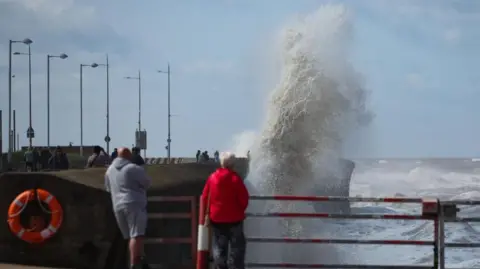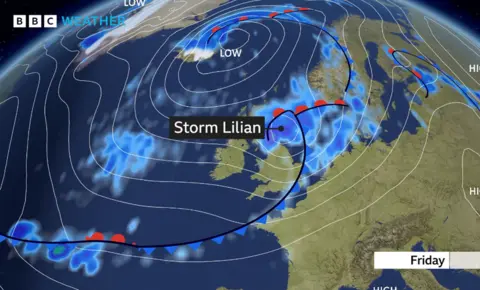
 EPA
EPA
Storm Lilian saw strong winds and heavy rain hit parts of the UK on Friday, bringing travel disruption and power cuts which left thousands without electricity.
Powerful gusts forced organisers at the Leeds Music festival to close three stages, while Creamfields Festival in Cheshire had to delay opening its gates.
Northern Powergrid said more than 60,000 customers were affected by “high levels of disruption” to electricity supplies.
The storm brought 70mph winds to the north west of England and Wales early on Friday, before moving eastwards.
It is expected to hit parts of the south of England on Saturday.
Gusts of 50-60mph were recorded widely on Friday and winds have reached 72mph at Capel Curig in Wales.
Met Office weather warnings were in force for parts of the UK but have now expired after conditions improved for most.
However, the Met Office has issued a further yellow weather warning for heavy rain on Saturday from 06:00-13:00 BST for much of south east England, meaning some disruption and flooding is possible.
‘Tents in the sky’
Festivalgoers hoping for an early start in Leeds had their plans disrupted when organisers said they would delay the opening of the site’s main arena.
The BBC Radio 1, Chevron and Aux were closed due to high winds and will not open until Saturday.
Attendees were advised to stay in their tents and cars until it was safe enough to venture out amid 60mph winds.
University student Carrie Gill, 19, said the weather had made the experience the “worst day ever”.
She said she had seen “people’s tents in the sky”, adding that her own had flooded with rainwater and had to be replaced.
Tegan Mcivor told the BBC how she and her partner became a “bit lost” on the way to the festival after road signs were knocked over by the wind.
“I’m pregnant and I’m hoping the wind doesn’t blow the tent away,” she added.
With the weather improving at the site and across much of northern England as Friday progressed, festivalgoers were heard sharing tips on repairing damaged tents as the first acts took to the main stage.


Northern Powergrid – which supplies electricity to the north east of England, Yorkshire and northern Lincolnshire – said 36,000 people were still waiting to be reconnected as of Friday afternoon.
Electricity North West said engineers had restored power to almost 15,000 homes in north-west England, and were working to restore power in 3,000 more.
On Friday morning, National Rail reported disruption caused by trees blocking lines in several parts of the country. It later said many services have returned to normal.
Metrolink tram services in Greater Manchester were also suspended on some routes.
British Airways cancelled 14 flights scheduled to take off from Heathrow on Friday morning and delayed others due to strong winds.
The M48 Severn Bridge in Gloucestershire was temporarily closed, while motorists were told to expect disruption on the M6 motorway, A66 and A1.
Winds are expected to calm over the bank holiday weekend, although wet weather is set to continue.
Why is it so windy in the UK?
By Simon King, BBC Weather

 BBC Weather
BBC Weather
Lilian is the twelfth named storm of the current 12-month cycle, which ends in September.
It is the first time there have been that many named storms in a single cycle since the system was introduced by the Met Office in 2015.
While there were two named storms last August, Storm Lilian is more typical of an autumn storm.
Lilian is a deep area of low pressure which formed quite rapidly on Thursday night.
In meteorology, low pressure systems are the ones that give us the wet and windy weather.
The lower the pressure, the larger the pressure gradient is around its centre, which in turn creates strong winds.
These areas of low pressure have been directed to us by a fast wind high in the atmosphere flowing across the Atlantic.
Over the last few days, the jet stream has been particularly active, bringing the remnants of ex-hurricane Ernesto to our shores as well as creating Storm Lilian.








